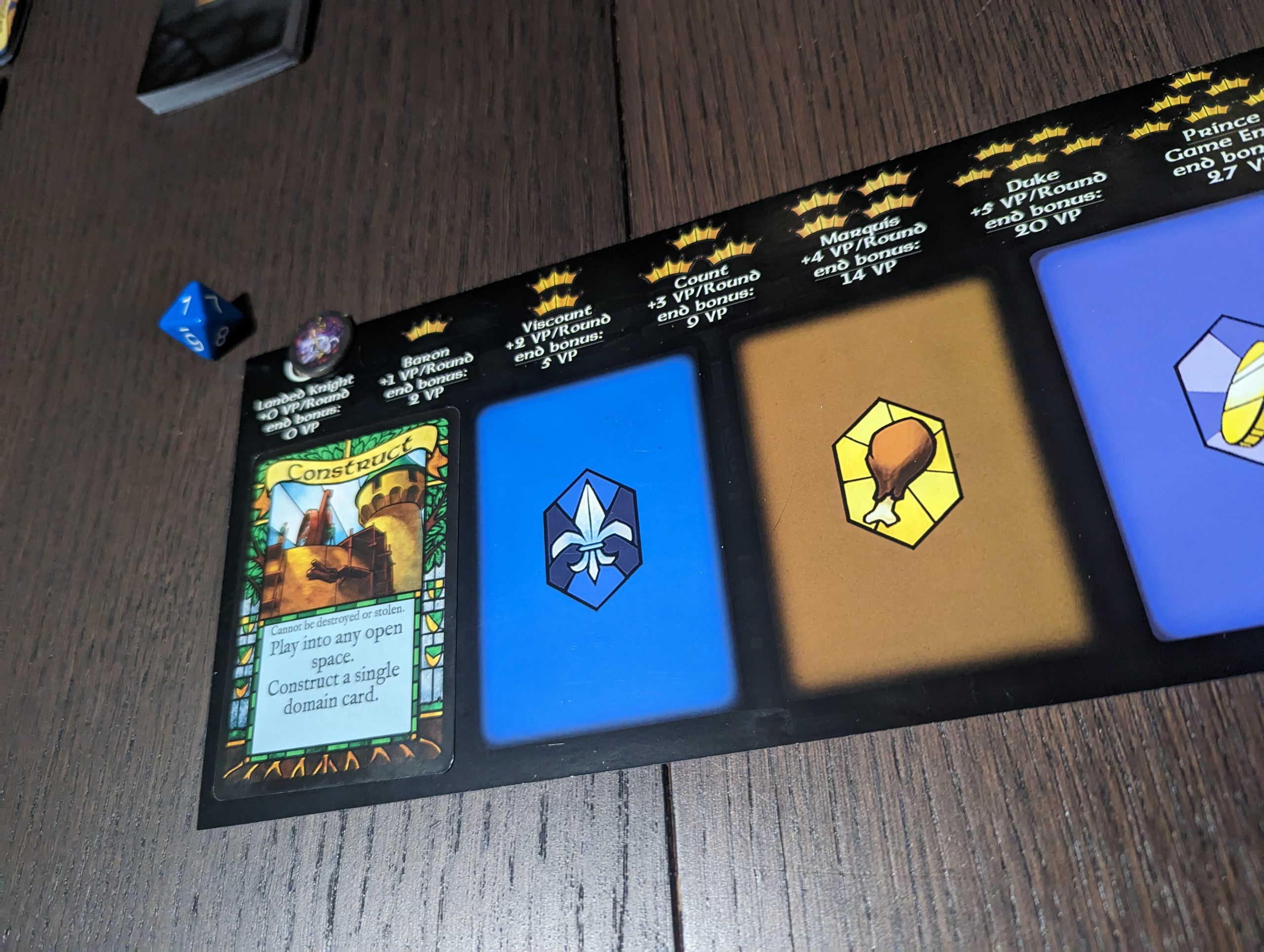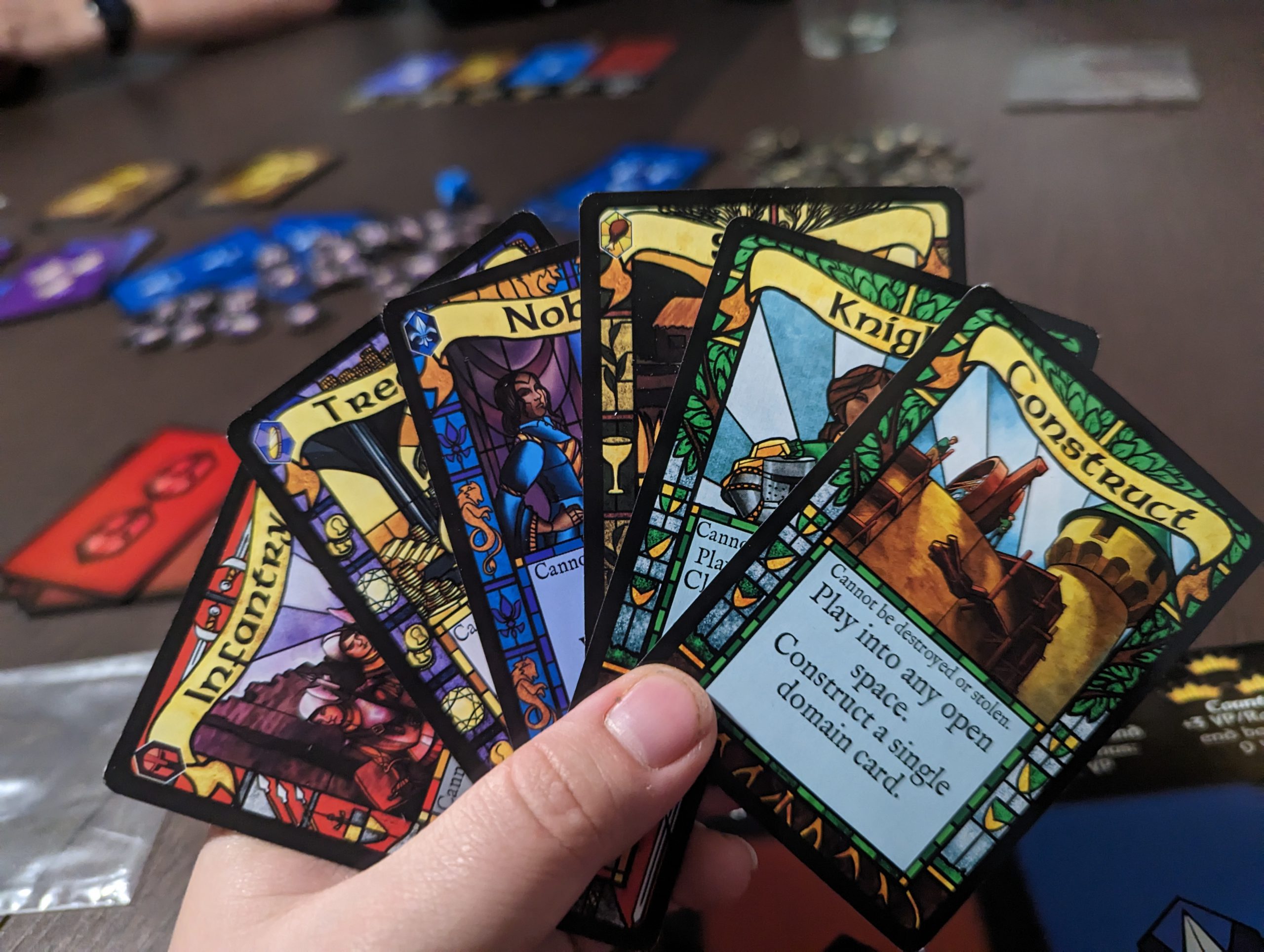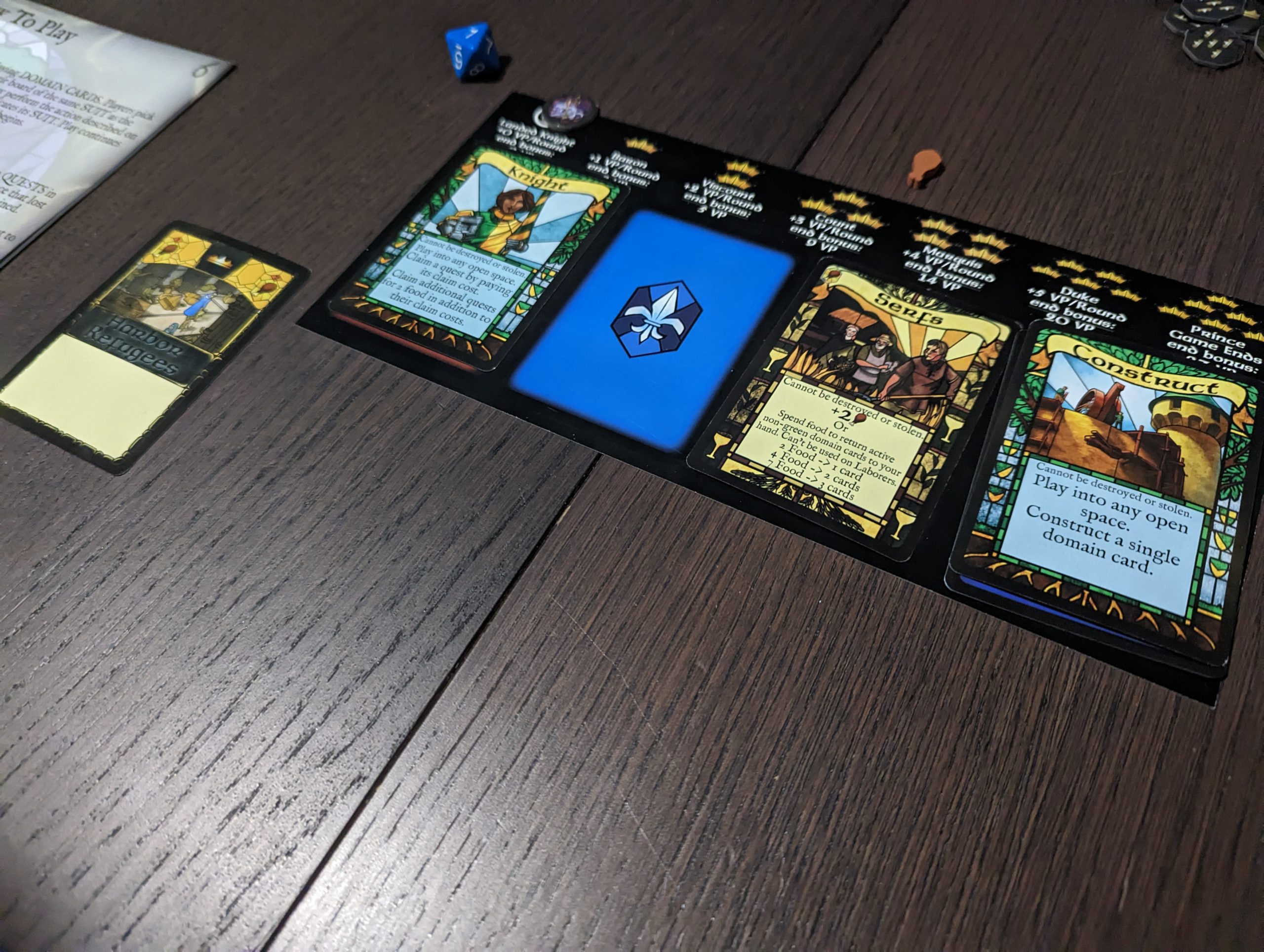Crown of Exile pits players against each other in a deck-building race for the crown
The King and his heir are dead, so you’re back in for a shot at the crown. Crown of Exile throws players into a medieval succession crisis, where noble houses race to claim the now-vacant throne.
The B3 ‘South’ Tabletop group rarely dabbles in heavier games, usually opting for games that are quicker to set up or ones that can handle a lot of players (and take a short time to learn). As such, we’re usually a trivia or party-game kind of group. There were nine of us in attendance at this meet, and we had some reservations about the depth of Crown of Exile when it came out — but everybody really got into the swing of things quickly and had a lot of fun.
Crown of Exile is a 2-5 player deck-builder where players play cards from their hand in sequence, gradually building up a more powerful hand to allow them to complete quests and, ultimately, capture the crown. In our case, we played as four teams of two, while a fifth player was solo.
Each player starts with an identical hand comprised of one card of each of the four main categories and two of the Green, wild-card/family cards. The categories of the cards are essential to the game, as they can only be played on the player’s board space matching its colour (except in the case of green cards, which have their own rules or are wild).
In the centre of the play space a series of Green, wild cards are stacked, while tier two and tier three cards are also placed for each of the four categories of cards. Finally, a row of four quests (five in a five-player game) is laid out along the bottom.

Each player has a tracker in front of them. On it, there is a space for them to track their rank in the kingdom (which is based on quests) and the rewards they get for holding those ranks. It also has four spaces for players to place their cards during their turns; one Yellow, one Blue, one Red and one Purple. The Yellow cards loosely correspond to food, peasantry and villages; the Blue to nobles, entertainment and influence; the Red to soldiers, military and war; and the Purple to merchants, trade and economy. These spaces each correspond to the cards you can play on them, which must be that colour unless the card is Green which have their own rules.
Gameplay is simple, with the starting player placing one card from their hand onto a legal tile, performing the action on it, and then the next player doing so until everybody around the board has filled each of the four tiles in front of them. There are cards later which allow you to return played (active) cards to your hand, which essentially gains you an extra go; and there are a lot of cards where, when played (active) they continue to have effects throughout the rest of the round.
Once everybody has filled all of their spaces the players resolve any upkeep on quests (which I’ll get to in a second), flog off any quests they can’t afford, and then reap the rewards of any quest gains as well as any bonuses from the cards they chose to make active in their turn. In addition to this, each player has a House card (chosen from one of two, given to them concealed at the start of the game) which might come into play at this point. After this is done, the first move shifts to the next player. The game is eight rounds long, so each player should get the chance to deploy at least 32 cards, at that point the victory scores are tallied up and a victor is declared — the exception to this is if a player reaches Prince rank before, which triggers the ending earlier but requires a mass of maintained quests.
Where Crown of Exile gets interesting is how you build your deck. Each player starts with two green cards, which can be played on any of the four spaces on their turn. One is the Knight, which allows you to buy a quest for the cost price — there is a second price, which is the upkeep cost that you pay at the end of your turn to keep it — while the other is a Construct card. The Construct card allows you to claim a card from the table’s central reserve of cards. Players can claim a tier two card of the colour that the Construct Card is placed on, or, if they have a tier two card already they can claim a tier three one. Instead of claiming one of these, though, they can instead claim from the Green piles, which allow you to place the green card on any of four tiles and place another card on top — meaning you can double, triple, or quadruple place cards of one colour rather than following the normal patterning.
An interesting thing starts to happen once players start buying into Crown of Exile‘s central reserve: players realise that the piles aren’t infinite, and so it’s very possible that players can block each other from accessing the tier three pile by buying out all of the tier two ones. And, why wouldn’t you? The tier three cards are incredibly powerful, and they often directly relate to the appropriate supply tokens (Soldier/Food/Influence/Coin) which are needed to afford and maintain quests.
While playing, a few of our players noticed that the starting quests we’d been dealt all focused on food. This started a race to claim the tier two and tier three city piles, cutting others out of the game… however, the quests that came after (and, a starting player can purge a quest at the start of their turn) were focused more on influence and soldiers. Soldiers, and their cards, often focus on stealing from others, however, you can’t steal influence… as a result of this other players started using their guards to steal food, and players started shifting to claiming the blue-backed Influence/Nobles/Entertainment cards.
The ultimate route to victory in Crown of Exile is in claiming quest cards. You do this by laying the Knight card on any of your four tokens. You’ll need to be able to afford the cost of buying the quest, but after that, it’s yours unless you fail an upkeep cost later on. Most of the quests also have some sort of action on them which comes into play at the end of the round, but the ones with the most powerful actions on them often don’t give you the crowns you need to rank up.
As part of the ending of a round players add their quest crowns together and move around the rankings… This is the only time we got a bit muddled during play, each rank has a + number on it as well as a ’round end’ number on it too. The instructions (we had the Kickstarter version) were unclear as to whether you gain both numbers at the end of the round, or whether the top number is only gained when you move to that rank. The former gives a massive bonus to anybody who races to the first crown, while the latter seems a bit fairer, but the wording is unclear and doesn’t clarify what happens when you lose rank but then regain it.
Crown of Exile was fantastic fun, and once we got moving everybody suddenly became a cunning kingmaker, with a not-so-subtle social, guessing element coming to the foreground.
Crown of Exile seems to currently be out of print, however, some online retailers, like nobleknight, have stock of the Kickstarter version.
Love board games? Check out our list of the top board games we’ve reviewed.




Comments are closed.